
Devastating Monsoon Downpours Ravage Pakistan, Claiming Dozens of Lives
Pakistan's Monsoon Crisis Deepens as Death Toll Climbs to 54 in Single Day
Pakistan's deadly monsoon season has claimed 54 lives in just 24 hours, with Punjab province bearing the brunt of the devastation, according to the country's disaster management authority. The latest casualties underscore Pakistan's growing vulnerability to extreme weather events that have become increasingly frequent and deadly in recent years.
Punjab Province Hit Hardest by Torrential Rains
A spokesperson for Pakistan's National Disaster Management Authority confirmed that the majority of the 54 fatalities occurred in Punjab, the country's most populous province and agricultural heartland. An additional 227 people were injured during the same 24-hour period ending Thursday at 8:00 AM local time.
Punjab's vulnerability to monsoon flooding stems from its flat terrain and dense population centers, which create perfect conditions for rapid water accumulation and limited evacuation options. The province, home to over 120 million people, contains major cities including Lahore and Faisalabad that regularly struggle with inadequate drainage infrastructure.
A Pattern of Escalating Climate Disasters
This latest tragedy follows Pakistan's catastrophic 2022 monsoon season, which killed over 1,700 people and affected 33 million citizens—nearly one-seventh of the country's population. The 2022 floods caused an estimated $30 billion in damages and highlighted Pakistan's position as one of the world's most climate-vulnerable nations despite contributing less than 1% of global greenhouse gas emissions.
Infrastructure Gaps Amplify Natural Disasters
Pakistan's monsoon casualties reflect deeper structural challenges beyond weather patterns. Decades of underinvestment in flood management systems, early warning networks, and urban planning have left communities exposed to predictable seasonal rains. Many areas lack proper drainage systems, while rapid urbanization has reduced natural water absorption capacity.
The country's disaster preparedness also suffers from coordination issues between federal and provincial authorities, often delaying emergency response when hours can mean the difference between life and death.
Economic and Agricultural Implications
Beyond the human toll, Punjab's agricultural sector—which produces roughly 60% of Pakistan's food supply—faces significant disruption. Crop damage during monsoon season typically drives food inflation and strains Pakistan's already fragile economy, which is currently operating under an International Monetary Fund bailout program.
The timing of these rains during the crucial Kharif crop season, when rice, cotton, and sugarcane are typically harvested, could exacerbate food security concerns and impact export revenues that Pakistan desperately needs for economic stability.
Regional Context and Future Outlook
Pakistan's monsoon crisis mirrors broader South Asian challenges with extreme weather. However, neighboring India has invested heavily in meteorological infrastructure and early warning systems, resulting in significantly lower casualty rates despite similar weather patterns. Bangladesh has also developed innovative flood management strategies, including floating agriculture and community-based disaster response systems.
Climate scientists predict that monsoon patterns will become more erratic and intense across South Asia, making Pakistan's current infrastructure gaps increasingly dangerous. Without substantial investment in flood management and disaster preparedness, annual monsoon seasons will likely continue claiming hundreds of lives and billions in economic losses.
Most Viewed News

 Layla Al Mansoori
Layla Al Mansoori






